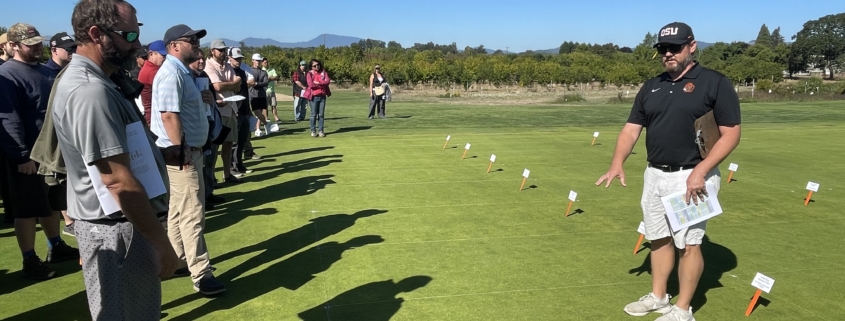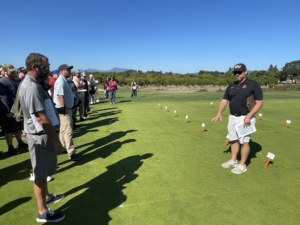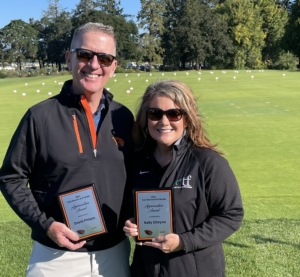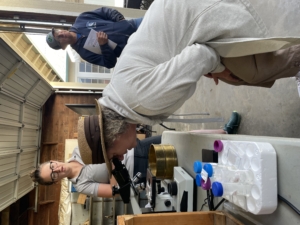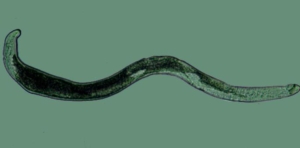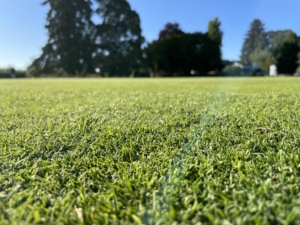Turfgrass Field Day Digs Into Latest Research
Researchers at Oregon State University’s turf management program held their annual Turfgrass Field Day Aug. 29 at the Lewis-Brown Farm near Corvallis, providing updates on several projects related to pest control, winter injury, carbon sequestration, and more.
The morning began with a series of short presentations before moving to field tours and an open house, where attendees strolled past verdant putting greens, lush fescue trials, and could even glimpse tiny nematodes through a microscope.
Field tours included fungicide, herbicide, and irrigation efficiency studies, along with perennial ryegrass trials conducted with the National Turfgrass Evaluation Program (NTEP) and fine fescue trials conducted as part of the Alliance of Low-Input Sustainable Turf.
Chas Schmid (right), senior researcher with the OSU BeaverTurf program, discusses topdressing treatments for golf course putting greens during the annual Turfgrass Field Day on Aug. 29.
Alumni and Friends
Two industry leaders were presented with Alumni and Friends awards from OSU BeaverTurf, recognizing their contributions to the turfgrass industry.
Sally Cheyne, Executive Director of the Oregon Turfgrass Foundation, and David Phipps, Northwest Field Staff Representative for the Golf Course Superintendents Association of America (GCSAA), were presented with the awards by Alec Kowalewski, Professor and turfgrass specialist for OSU.
OSA offers our congratulations to Cheyne and Phipps! Thank you for your incredible support of Oregon seed and turfgrass producers.
David Phipps and Sally Cheyne received Alumni and Friends awards from OSU BeaverTurf.
Diagnostic Lab Update
Chas Schmid, an assistant professor at OSU and senior researcher with the BeaverTurf program, gave an update on the university’s Turfgrass Diagnostic Lab.
Schmid said they are seeing an uptick in samples this summer with the diseases Pythium root rot and summer patch. Over-watering and over-fertilizing — particularly after periods of drought and going into hot weather — are a “recipe for disaster” for Pythium, he said.
The turfgrass team is also working with the U.S. Golf Association on a $30 million initiative to reduce water consumption by 45% over the next 15 years. As part of that effort, Schmid said they are experimenting with the height and angle of irrigation heads to see if they result in greater efficiency.
“Hopefully we’ll have some answers for you next year,” Schmid said.
Winter Damage
Two separate projects are underway at BeaverTurf examining winter damage at golf courses in Central Oregon, as well as damage caused by foot and cart traffic during frost.
Cole Stover, a graduate assistant at OSU, is leading the work in Central Oregon. For three years between 2021 and 2024, he flew a DJI Inspire 2 drone equipped with a multispectral camera and thermal sensor over four golf courses near Bend. Flyovers were done monthly from December 2021 through May 2024 to monitor winter damage.
The DJI Inspire 2 drone was used to survey winter damage on four golf courses near Bend.
Results showed that surface temperature data could be used to predict areas of turf damage in spring. Damage is more likely to occur at minus-8 degrees Celsius, Stover said.
Stover also suggested it may be best to leave snow in place rather than remove it on golf courses, unless there is a chance it could thaw and then re-freeze forming a layer of ice.
Alec Kowalewski, professor and turfgrass specialist with BeaverTurf, led tests last year to determine whether foot and cart traffic caused damage during frost on golf courses. According to his study, frost was observed each morning from Jan. 30 to Feb. 13.
Results of the study, funded by the USGA, showed foot traffic did not cause significant damage to annual bluegrass putting greens. However cart traffic did cause “unacceptable” damage on taller bentgrass fairways.
“If it is a frozen morning, you should not have carts on the golf course for the entire day,” Kowalewski said.
Nematode Surveys
Emily Braithwaite, a graduate assistant at OSU, said surveys are showing increasing concentrations of microscopic nematodes in turfgrass across the Pacific Northwest.
The parasitic worms are harmful because they feed on the roots of grass, causing damage.
“Nematodes are much more widespread than we initially thought,” Braithwaite said.
Tina Lyons, owner of Double River Forwarding in Portland, observes nematode samples through a microscope at OSU Turfgrass Field Day on Aug. 29.
Example of a root-knot nematode. (Source: Center for Invasive Species and Ecosystem Health)
The survey, funded by the USGA, identified 15 unique types of nematodes in turfgrass, versus just 1-2 in crops such as soybeans. Damage was primarily observed from January through March, during periods of reduced growth.
Braithwaite said the next step is finding best management practices such as optimized spraying to keep the tiny parasites under control.
Carbon Sequestration
Zach Hamilton, a graduate assistant, discussed how grass length and frequency of mowing impacts the amount of carbon the plants are able to sequester.
Hamilton conducted research in a 40-year-old turfgrass stand at Lewis-Brown Farm, collecting data every two weeks from January 2021 through December 2022. He evaluated the photosynthesis of grass mowed at different lengths and intervals, including 5 centimeters monthly; 5 centimeters weekly; and 10 centimeters weekly.
Preliminary findings show the higher-cut grass sequestered more carbon, but with greater mowing frequency came greater carbon emissions, potentially offsetting the storage. Hamilton added that younger grass stands could have the ability to sequester more carbon underground.
Sunlight shines on a putting green at Lewis-Brown Farm near Corvallis.

